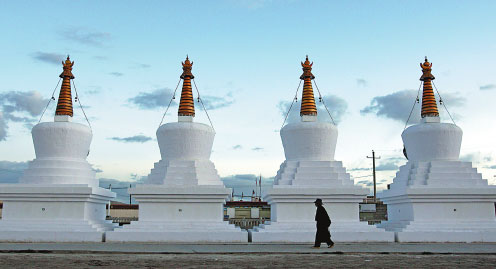Editor's note: China is marking the 50th anniversary of the founding of the Tibet autonomous region. In the coming weeks China Daily will bring you in-depth reports about developments in the region in the past half-century, focusing on culture and religion, environmental protection and eco-tourism.
Visitors are flocking to Tibet, one of the world's remotest holiday destinations, as a result of massive investment in the region's transportation infrastructure, report Luo Wangshu in Xigaze and Xin Dingding in Beijing.

A man admires the view as he circles stupas in Nagqu prefecture, Tibet. (Photo: China Daily/Wang Zhuangfei)
Driving in Tibet was once considered a dangerous line of work. So much so, that the locals still tie brightly colored flags signaling "good luck" to cables and rocks on the peak of every mountain and hill.
"The flags are there to wish passers-by a safe journey," explained Yarphel, who has 22 years experience as a local government driver in Ngari prefecture in the Tibet autonomous region - often referred to as "the roof of the world".
During his long working life, Yarphel has developed a special routine and follows a number of rituals. Whenever he drives past the peak of a mountain, he honks his horn. "It's a greeting to the gods, asking them to bless us," he said. More prosaically, it's also a good way to let other motorists know he's there. "On unpaved roads, visibility is often zero because your vision is obscured by the clouds of dust that rise from the road surface," he said.
Yarphel has encountered this situation many times on his travels between Xigaze prefecture and Burang, a county in Ngari, the home of Mount Kailash and Lake Manasarovar, which are both regarded as holy features by the local Budd-hists. "I constantly have to step on the brakes and slow down," he said.
The 1,100-kilometer journey from Xigaze to Burang used to take at least two days, because "driving 12 hours a day on such a bumpy road was hard and I was exhausted pretty quickly", he added.
Things changed when the road was asphalted, cutting the journey time by half. "Driving on the new road means the journey is no longer such a tiring experience," he said.
The upgraded transportation infrastructure has also benefited Gelek Gyatso, a senior monk at Lingbu Monastery in Gyangze county.
The monastery is on the top of a hill, and the only access to the main road was previously via a narrow dirt path that was unable to accommodate cars. Every time Gelek Gyatso and the other monks returned from a nearby town with a carload of groceries, they had to carry the goods up the hill themselves.
"We dropped the goods at the foot of the hill and then walked up to the top. We had to walk back and forth several times to carry all the items to the monastery. Each load took 30 to 40 minutes to transport," he said.
In 2011, the local government invested 2.6 million yuan ($460,000) to build a 2.5-km-long paved road connecting the monastery with the main road. It now takes about five minutes to drive between the two.
According to Tsering Nyodrub, head of the United Front Work Department in Gyangze, monasteries are usually built on hills, and that makes traveling difficult for monks and pilgrims. Since 2011, the regional government has invested about 1.5 million yuan in the construction of roads near monasteries and other religious sites. The five-year road-building project aims to make 70 percent of the region's 1,700 registered monasteries accessible by the end of the year.
However, that sum was just a drop in the ocean of the total investment the government has made in Tibet's transportation infrastructure in the past 50 years. The local transportation authority said that in 1950 the region had no paved roads, but by the end of last year, 75,000 km had been constructed. Medog, the last county in China unconnected to the outside world by road, was linked to the national highway network in 2013.
In 2006, a railway was opened to link Lhasa, the capital of Tibet, with neighboring Qinghai province. The line was later extended as far as Xigaze, Tibet's second-largest city.
The region is mountainous, so it's expensive to build roads and railways. To compensate for this, civil airports were built in Lhasa, Qamdo, Nyingchi, Ngari and Xigaze, and nine airlines operate 310 flights per week to 38 cities.
The improvement of the transportation infrastructure has not only benefited the locals, but also brought a large number of visitors to Tibet, where tourism is a pillar industry.
The region's airports received 3.15 million visitors last year, and the tourism authority said the number of tourists has grown by as much as 30 percent annually since the Xigaze airport was opened in 2013.
The airport in Nyingchi was opened in 2006, and last year 1.52 million tourists visited the prefecture, generating revenue of 1.11 billion yuan, 11 times the amount in 2005.
The Lhasa-Xigaze railway, which opened on Aug 16 last year, has also carried large numbers of tourists to Xigaze, home of the mountaineers' base camp for Qomolangma, known in the West as Mount Everest.
Batsang, deputy director of the Xigaze Development and Reform Commission, said more than 40,000 visitors used the railway in the first month of operation.
The railways and roads will be extended to other parts of the region over time, and there are plans to build new railways to link Lhasa and Nyingchi, and to connect Xigaze with the counties of Gyirong and Yadong, which both boast stunning tourist attractions but are difficult to access.
"Many tourists want to travel in Tibet, but in the past they were discouraged by the limited transportation options available. As the options increase, visitors will have access to many more attractions that are just waiting to be explored," Phurbu Tashi, head of the Xigaze Tourism Bureau, said.


















































